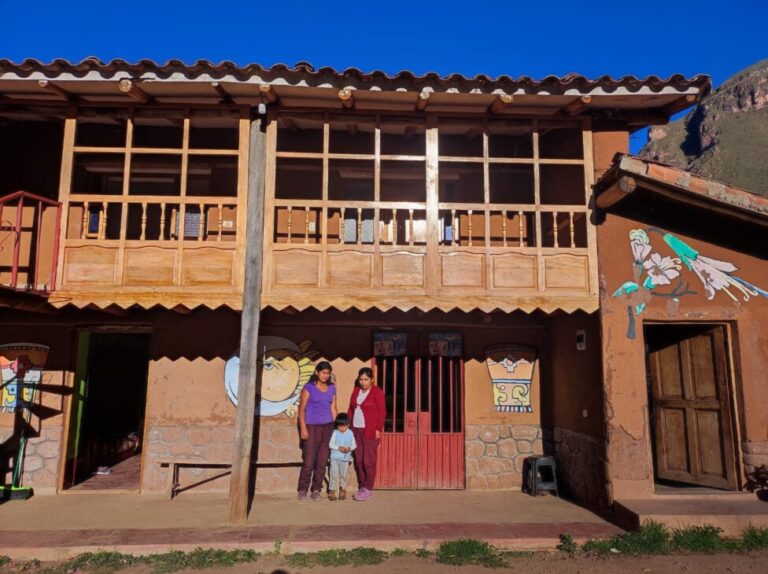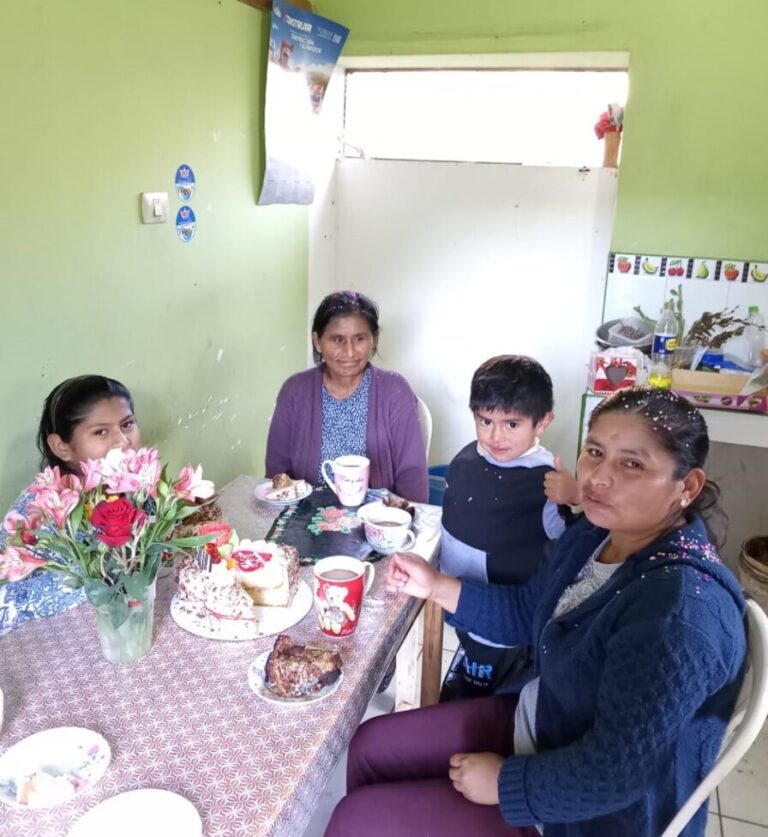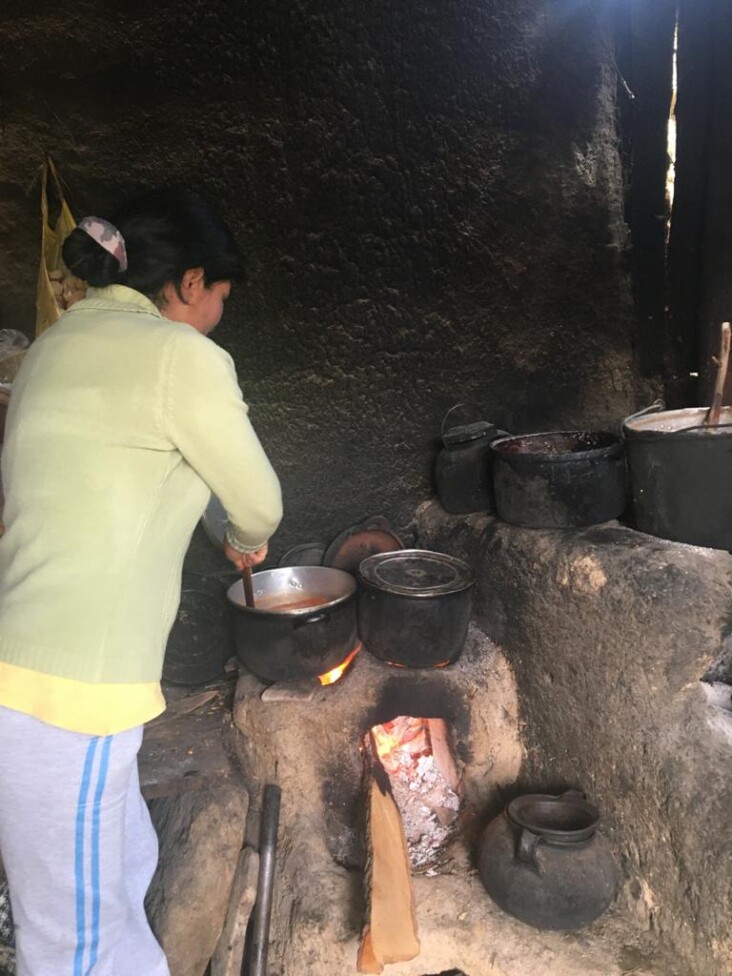
Martina Santa Cruz, a peasant farmer from the village of Sacllo in the southern Peruvian Andes highlands department of Cuzco, is pleased with her remodeled kitchen where a skylight was created to let in sunlight and a chimney has been installed to extract smoke from the stove where she cooks most of the family meals. She is disappointed because a wall was stained black when she recently left something on the fire for too long. But her husband is about to paint it, because they like to keep everything clean and tidy. CREDIT: Janet Nina/IPS
By Mariela Jara
CUZCO, Peru, Jun 15 2023 – Adopting a “healthy housing” approach is improving the living conditions of rural Peruvian women like Martina Santa Cruz, a 34-year-old farmer who lives with her husband and two children in the village of Sacllo, 2,959 meters above sea level in the Andes highlands municipality of Calca.
“I used to have a wood-burning stove without a chimney, and the smoke filled the house. We coughed a lot and our eyes stung and it bothered us a lot,” she told IPS during a long telephone conversation from her village.”Rural families have the right to decent housing that provides them with quality of life and guarantees their health, safety, recreation and the means to feed themselves.” — Berta Tito
Santa Cruz, her husband, their 13-year-old daughter and their four-year-old son are among the 100 families who live in Sacllo, part of the Calca district and province, one of the 13 provinces that make up the southern Andes department of Cuzco, whose capital of the same name is known worldwide for the cultural and archaeological heritage of the Inca empire.
With an estimated population of more than 1,380,000 inhabitants, according to 2022 data from the National Institute of Statistics and Informatics, four percent of the national population of 33 million, Cuzco faces numerous challenges to fostering human development, especially in rural areas where social inequality is at its height.
According to official figures from May, 41 percent of Peru’s rural population currently lives in poverty, and in Calca, where 55 percent of families are rural, there are high rates of childhood malnutrition and anemia.
One way Santa Cruz found to improve her family’s health and carve out new opportunities to boost their income was to get involved in the project for healthy housing.
In 2019, she took part in a contest organized by the municipality of Calca, which enabled her to start remodeling their house, making it healthier and more comfortable.
Her husband, Manuel Figueroa, is a civil construction worker in the city of Cuzco, about 50 kilometers away by road. She stays home all day in charge of the household, their children, the chores, and productive activities such as tending the crops in their garden and feeding the animals.
“When I only cooked on the woodstove, I also had to get an arroba (11.5 kg) of firewood a day to be able to keep the fire lit all day long to cook the corn and beans, and the meals in general,” she said.
In addition to cooking food, the stove provided them with heat, especially in the wintertime when temperatures usually drop to below zero and have become colder due to climate change.

In the small village of Sacllo, in the Peruvian municipality of Calca, Martina Santa Cruz (L) poses with her two children, proud of having a healthy home that has improved the family’s living conditions. The house has been plastered with clay and has two stoves and a wooden balcony on the second floor where the bedrooms are located. CREDIT: Janet Nina/IPS
Healthy rural homes and communities
Jhabel Guzmán, an agronomist with extensive experience in healthy housing projects in different areas of Calca province, told IPS that the sustainability of the initiative lies in the fact that it incorporates the aspect of generating income.
“It is not enough to propose changing or upgrading stoves, improving order in the home or providing hygiene services; rural families need means to combat poverty,” he said.
Of the projects he has been involved in, the ones that have proven to be sustainable in time are those in which, together with improvements in relation to health, the transformation of the homes contributed to generating income through activities such as gardens, coops and sheds for small livestock, and experiential tourism, expanding the impact to the broader community.
The case of Santa Cruz and her family is heading in that direction. Their original home was built by her husband in 2013 with the support of a master builder and some neighbors, a total of eight people, who finished it in a month. They used local materials such as stones, earth, adobe and wooden poles.
But the two-story home was not plastered, which made it colder. In addition, it was not well-designed: the small livestock were in cramped pens, the bedrooms were crowded together on the ground floor, the stove had no chimney and the house was very dark.
Their participation in the healthy homes initiative marked the start of many changes.

Peruvian peasant farmer Martina Santa Cruz (R) sits with her mother (2nd-L) and her two children in the brightly lit kitchen-dining room where she cooks with gas. CREDIT: Courtesy of Martina Santa Cruz
“We plastered the house with clay, it turned out smooth and nice, and we painted a sun and a hummingbird (on the wall outside). In the kitchen I installed a wooden cabinet, we made a skylight in the roof and covered it with transparent roofing sheets to let the sunlight in, and we made a chimney for the smoke from the stove and fireplace,” said Santa Cruz.
“It feels good. There is no smoke anymore, I can keep things tidier, there is more light, the clay makes the house warmer, and my small animals, who live next door, are growing in number,” she said..
She also created a space for a gas cylinder stove and a dining room that she uses when there are guests and she needs more cooking power than just the woodstove, to prepare the food in less time.
Due to traditional gender roles, Peruvian women are still responsible for caretaking and housework, which take more time in rural areas due to precarious housing conditions and less access to water, among other factors, reducing their chances for studying, recreation, or community organization activities, for example.
Building large coops with small covered sheds with divisions for her guinea pigs and chickens made it easier for Santa Cruz to clean and feed them, therefore saving her time, which she aims to use for future gastronomic activities: cooking food for a small restaurant that she plans to build on her property.
She explained that she has 150 guinea pigs, rodents that are highly prized in the Andes highlands diet, which provide her family with nutritious meat as well as a source of extra income that she uses to buy fruit and other food.

A typical, unhealthy house in rural Peru where cooking is done using firewood in a closed room without a chimney, which causes smoke to spread throughout the house and damages the health of the families. CREDIT: Mariela Jara/IPS
Improving quality of life
Agronomist Berta Tito, from the Cuzco-based non-governmental organization Center for the Development of the Ayllu Peoples (Cedep Ayllu, which means community in the Quechua language), highlighted the importance of healthy housing in rural areas, such as Sacllo and others in the province of Calca, in a conversation with IPS.
She said they prevent lung diseases among family members, particularly women who inhale carbon dioxide by being in direct contact with the woodstove, while reducing pollution and improving mental health, especially of children.
“Rural families have the right to decent housing that provides them with quality of life and guarantees their health, safety, recreation and the means to feed themselves,” Tito said.

Berta Tito (C) stands in a greenhouse garden during a work day with peasant farmers from highland areas of Cuzco in Peru’s southern Andes. The agronomist from Cuzco stressed the importance of rural families accessing healthy homes as part of their rights. CREDIT: Mariela Jara/IPS
She said the project requires property planning, in which families commit to a vision of what they want to achieve in the future and in what timeframe. “And viewed holistically, this includes access to renewable energy,” she added.
In Santa Cruz’s house, the different areas are now well-organized: the ground floor is for cooking and other activities and the four bedrooms, one for each member of the family, are located on the second floor and are all lined with a beautiful wooden veranda.
At the moment she is frustrated that she left something on the woodstove too long, which stained the nearest wall black. But she and her husband have plans to paint it again soon, because the family enjoys having clean walls.
In addition to her two cooking areas, with the woodstove and the gas cylinder, she has a garden on the land next to her house, where she grows vegetables like onions, carrots, peas and zucchini, which she uses in their daily diet. And she is pleased because she can be certain of their quality, since the family fertilizes the land with the manure from their guinea pigs and chickens “which eat a completely natural diet.”
Future plans include fencing the yard and expanding an area to build a small restaurant. “That is my future project, to dedicate myself to gastronomy, cooking dishes based on the livestock I raise. I have the kitchen and the woodstove and oven and I can serve more people. But I will get there little by little,” she said confidently.